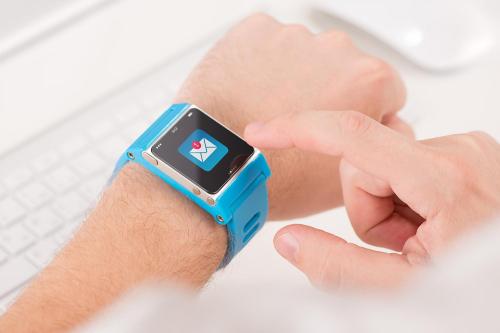
And now, along with your work laptop and smartphone, there’s a new type of tech worming its way into the workplace. All signs point to wearables being the next big consumer electronic trend to make a major impact on the hours of 9 to 5.
Remember how psyched you were the first time the guy from IT dropped your brand-new iPhone on your desk?
Companies like Salesforce are already bracing for this type of move. The workplace-computing company has been steadily adding many of the top wearable devices to Salesforce Wear, a platform devoted to opening up such devices to enterprise developers. The list of compatible products is already a long one, including Google Glass, Fitbit, Jawbone UP, Pebble, Oculus Rift, and several others.
It’s exciting, though. Remember how psyched you were the first time the guy from IT dropped your brand-new iPhone on your desk? A paycheck, healthcare and a shiny new Apple phone? Clearly you’d died and taken an elevator ride up to a heaven with mediocre coffee. Now, imagine that your new employee bundle also contained a pair of Google Glass.
It’s easy to see what’s in it for companies. I tried out a pair of augmented-reality glasses from Canon a while back that presented all sorts of fascinating possibilities. On the most basic level, there’s the ability to multi-task, receiving important notifications as you have your hands free for other projects. There’s also driving directions, contextual information and the even virtual reality. A car company, for example, could allow engineers to explore new models before they’re even built. Ford is already pulling this off.
At the moment, Saleforce’s approach is likely to be the most realistic — harness low-cost, mass-market technologies for business purposes. After all, those Canon MReal glasses carried a $125,000 price tag. I don’t care how valued of an employee you are, no IT person is going to be bringing one of those things up to your desk any time soon. Footing the bill for a Fitbit or even a pair of Google Glass, on the other hand, doesn’t seem like such an impossibility.
Of course, wearables at work (we’re all on-board to start calling these “workables,” right?) could potentially further complicate our relationships with our employers, too. The most immediate potential problem is the one highlight above that so many continental nations are working so hard to combat.
Think you’re having a hard time disconnecting from work email now? Imagine what would happen once your employer brings wearables into the picture. Think about it: Hardware like a Pebble smartwatch or Google Glass let you engage with messages at all times, without having to remove your smartphone from your pocket. Business wearables could — in some cases literally — put business messages in front of employees’ faces at all times.
As with smartphones, once you’ve entered into the verbal contract that comes with picking up that device, many employers will expect that you’ll always be at the ready. Excuses of not seeing emails won’t hold a lot of water. Of course, in many cases, the solution to that is, again, just as simple as disconnecting.
The bigger concern with such devices in the work environment is a question of privacy. A couple of weeks back, we took a look at some of some of the potential concerns surrounding data collection be wearable manufacturers. Jawbone wowed everyone with the graph it presented of wearer sleep patterns (or lack thereof) during the recent Napa, California earthquake. Almost immediately, however, privacy groups wanted to know what Jawbone was doing collecting and publishing that information.
Excuses of not seeing emails won’t hold a lot of water.
Earlier this year, public radio program Radiolab published a fairly damning look inside of Amazon warehouse cultures, in which inventory fulfillers are required to wear device that calculate the amount of time it should take a worker to locate an object in the space, counting down and ultimately penalizing them for going over. I got stressed out just listening to it. Sure, the story feels like an anomaly now, but as Amazon continues to set public expectations for this kind of immediacy, it’s hard to imagine that more companies won’t adopt similar practices moving ahead.
Workplace wearables may be a gateway to these types of practices, easing employees into being tracked, pestered and monitored with devices they’re already using.
Of course, any of these dystopian scenarios are still a way off. As I mentioned earlier, we’re not not even to the point where we can consider them fully mainstream in the consumer space. But given how business wearables are already being treated as a foregone conclusion, we’ve got a bit of a headstart in keeping an eye on how they’re implemented.